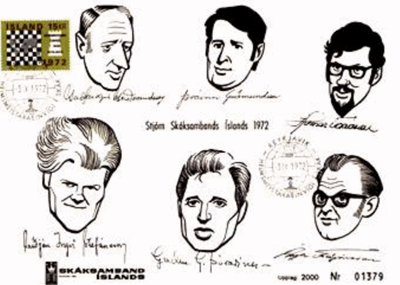GM Svetozar Gligoric, Player/Journalist
One point I've come to realize in this long Fischer Friday series -- last seen in Bags of Loot (August 2022) -- is that the 1972 Fischer - Spassky Match (m-w.com), was in fact two matches. The first match, which lasted from end-June 1972 through the third game, was all about whether Fischer would play. The first match had little to do with chess.
The second match, which started with the fourth game, was all about chess. Starting with the score at 2-1 in Spassky's favor, the players fought some of the most interesting games ever seen at the highest level of chess. The first match caught the attention of the entire world. The second match was mainly of interest to chess players.
The phrase 'all about chess' to describe the second match is not completely accurate. The off-board, psychological battles continued throughout the match, but they were largely ignored by the general public.
Darrach's book -- see According to Darrach, Day by Day (July 2022), for background -- starts with Fischer flying from the American West Coast to New York, then devotes 16 chapters to events before the fourth game. The last 18 games take up a single chapter.
Brady's 1973 book 'Profile of a Prodigy' spends 30 pages from the West Coast to the fourth game, followed by seven pages on the rest of the match. His 2011 book, 'Endgame' -- see Fischer's Best Games? (February 2011), for a summary of posts about the book -- spends even fewer pages to cover the same period.
Byrne & Nei's book -- see Spassky's Team (July 2022), for an introduction -- focuses on the games and the moves, not the politics and the psychology. The first third of the book is an analysis of Fischer's three candidate matches; for an overview of those matches, see 1970-72 Candidates Matches (m-w.com).
Gligoric's book 'Fischer v Spassky: The Chess Match of the Century' (Fontana, 1972), contains good accounts of the off-board happenings between games. What was GM Gligoric's relationship to the match? In 'Profile of a Prodigy' (p.222), Brady explains,
Fischer was scheduled to arrive in Iceland on June 26th. Journalists and chess lovers began to assemble in increasing numbers in Reykjavik. Feature writers of such renown as Pulitzer-prize winner Harold C. Schonberg, Arthur Koestler, Jeremy Bernstein, George Steiner, David Pryce-Jones, and Clement Freud arrived, while such noted chess writers as Harry Golombek, Heinrich Fraenkel, B.H. Wood, Jens Enevoldson, I.A. Horowitz, Robert Byrne, Larry Evans, Dimitrije Bjelica, Svetozar Gligoric and many others filed daily reports to their respective journals. Over two hundred and fifty journalists eventually made their way to Reykjavik. Though all of their script concerned the dynamics of the match, not all was chess.
Gligoric's full page introduction to the fourth game starts,
After the adjournment of the third game Spassky made no protest, just a simple statement that he would not play in the back room again. The referees agreed with the champion. When built, the spacious room had been intended for table tennis. During those five hours of playing chess there it was discovered that all kinds of outside noise could be heard: traffic on the road above, cars in the parking lot, children playing on the near-by grounds.
What about Fischer? A friend remarked: 'That was the right kind of noise. Not like that from cameras.' This makes sense. In certain countries which are less touched by Western civilisation, people do not agree to be photographed! Fischer was not acting. His dislike for cameras was in-born; a genuine one. There were years of his solitary life when not one recent photo of Bobby could be found for the press.
Nearly every other game starts at least with a similar full page introduction. Gligoric was no slouch at chess either. He played in eight Interzonals and three Candidate tournaments, including two round robins and one knockout event, the 1967-69 Candidates Matches (m-w.com), where he was eliminated in the first, quarterfinal round by Mikhail Tal. Gligoric was one of the strongest player/journalists of all time.
[On this date 50 years ago, the players were preparing for the 19th game. I watched that game (start to finish?), an Alekhine's Defense, on Shelby Lyman's PBS show. In 1972, it was TV chess at its best. The game made a huge impression on me and I realized how little I knew about chess.]
***
Coincidental to this series I found the following image while doing an unrelated search on my archive of eBay images.

The description of the eBay auction said, 'Larger size card showing caricatures of the board of the Icelandic Chess Federation who organized the 1972 World Chess Championship Match.' The ICF officials were not identified and the only one I recognize is Gudmundur Thorarinsson, bottom row center; see Legends of the 1972 Match (June 2022), and Drawing for Colors in 1972 (July 2022). I can guess at one or two of the other faces/signatures, but I'll wait for a more definitive explanation.
***
Later: Re 'The ICF officials were not identified', they are identified on this page: Le match du siècle 1972 (histoire-echecs-philatelie.com); 'The match of the century 1972 (history-chess-philately)'.
Gudlaugur Gudmundsson (membre), Thrainn Gudmundsson (secretaire), Hilmar Viggosson (caissier), Gudjon Ingvi Stefansson (membre), Gudmundur G. Thorarinsson (président), Asgeir Fridjonsson (vice président)
The French language titles in parentheses are easily understood in English, with the exception of 'caissier', which means 'treasurer'.




No comments:
Post a Comment